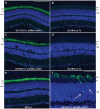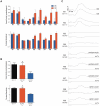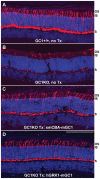Functional and behavioral restoration of vision by gene therapy in the guanylate cyclase-1 (GC1) knockout mouse
- PMID: 20593011
- PMCID: PMC2892468
- DOI: 10.1371/journal.pone.0011306
Functional and behavioral restoration of vision by gene therapy in the guanylate cyclase-1 (GC1) knockout mouse
Abstract
Background: Recessive mutations in guanylate cyclase-1 (Gucy2d) are associated with severe, early onset Leber congenital amaurosis-1(LCA1). Gucy2d encodes guanylate cyclase (GC1) is expressed in photoreceptor outer segment membranes and produces cGMP in these cells. LCA1 patients present in infancy with severely impaired vision and extinguished electroretinogram (ERG) but retain some photoreceptors in both their macular and peripheral retina for years. Like LCA1 patients, loss of cone function in the GC1 knockout (GC1KO) mouse precedes cone degeneration. The purpose of this study was to test whether delivery of functional GC1 to cone cells of the postnatal GC1KO mouse could restore function to these cells.
Methodology/principal findings: Serotype 5 AAV vectors containing either a photoreceptor-specific, rhodopsin kinase (hGRK1) or ubiquitous (smCBA) promoter driving expression of wild type murine GC1 were subretinally delivered to one eye of P14 GC1KO mice. Visual function (ERG) was analyzed in treated and untreated eyes until 3 months post injection. AAV-treated, isogenic wild type and uninjected control mice were evaluated for restoration of visual behavior using optomotor testing. At 3 months post injection, all animals were sacrificed, and their treated and untreated retinas assayed for expression of GC1 and localization of cone arrestin. Cone-mediated function was restored to treated eyes of GC1KO mice (ERG amplitudes were approximately 45% of normal). Treatment effect was stable for at least 3 months. Robust improvements in cone-mediated visual behavior were also observed, with responses of treated mice being similar or identical to that of wild type mice. AAV-vectored GC1 expression was found in photoreceptors and cone cells were preserved in treated retinas.
Conclusions/significance: This is the first demonstration of gene-based restoration of both visual function/vision-elicited behavior and cone preservation in a mammalian model of GC1 deficiency. Importantly, results were obtained using a well characterized, clinically relevant AAV vector. These results lay the ground work for the development of an AAV-based gene therapy vector for the treatment of LCA1.
Conflict of interest statement
Figures







References
-
- Perrault I, Rozet JM, Calvas P, Gerber S, Camuzat A, et al. Retinal-specific guanylate cyclase gene mutations in Leber's congenital amaurosis. Nat Genet. 1996;14:461–464. - PubMed
-
- Dizhoor AM, Lowe DG, Olshevskaya EV, Laura RP, Hurley JB. The human photoreceptor membrane guanylyl cyclase, RetGC, is present in outer segments and is regulated by calcium and a soluble activator. Neuron. 1994;12:1345–52. - PubMed
-
- Liu X, Seno K, Nishizawa Y, Hayashi F, Yamazaki A, et al. Ultrastructural localization of retinal guanylate cyclase in human and monkey retinas. Exp Eye Res. 1994;59:761–8. - PubMed
-
- Burns ME, Arshavsky VY. Beyond counting photons: trials and trends in vertebrate visual transduction. Neuron. 2005;48:387–401. Review. - PubMed
Publication types
MeSH terms
Substances
Grants and funding
LinkOut - more resources
Full Text Sources
Other Literature Sources
Medical
Molecular Biology Databases
Research Materials

